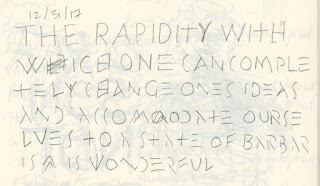The intaglio printing process I am using in Character Traits is fairly standard, with just a few peculiarities based on my use of photopolymer plates. For most of the plates, particularly those with thicker line work, I need to modify the ink I'm using by adding a substantial quantity of magnesium carbonate. Without the magnesium, the ink is too easily wiped out of the lines prior to printing, and, during printing, has trouble holding a crisp edge. Polymer plates also present some difficulty during the inking and wiping process due to their light weight—they don't want to sit still, and an already messy process quickly becomes unmanageable. To compensate, I am taking advantage of the plates' steel backing by sticking them on Bunting magnetic bases while inking and wiping. This keeps the plate in place and gives me a larger surface on which to work. To protect the surface of the magnetic bases I place a sheet of stiff cover stock between plate and base. The paper barrier also makes lifting the plate from the magnet much easier than it would be otherwise.
For most plates, the steps are as follows:
Place the plate down on the paper-covered magnetic base

Draw ink across the plate with a plastic squeegee, rocking the edge back and forth to force the ink into the larger areas; scrape the surface of the plate with the squeegee to remove excess ink
Wipe with tarlatan twice (with each tarlatan session I use progressively
cleaner pieces of material to prevent ink transferring back to the
plate from the tarlatan)
Wipe with the edge of my hand vertically, horizontally, and at 45 degrees. Then wipe a third time with tarlatan
Lift the plate off the magnetic base and use a galley magnet to hold the plate while wiping the edges with mineral spirits
Place a cleaner sheet of paper on the base before replacing the plate (throughout the edition I regular change these sheets of paper to prevent ink transferring back from the paper to the plate during wiping)
Wipe with tarlatan and then polish with newsprint, repeating this process once or twice depending on the plate
Clean the edges one last time
Place the plate on the bed of the press
Then Nancy places the dampened sheet of paper, cranks the press and lifts the print, after which we begin the process again
























